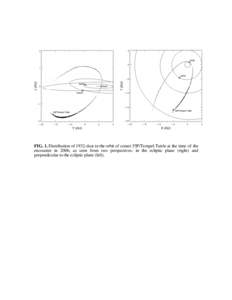 Date: 2007-10-26 19:00:22Observational astronomy Leo constellation Leonids Space Zenithal Hourly Rate Radiant Absolute magnitude Meteor showers Meteoroids Astronomy | |  FIG. 1. Distribution of 1932-dust in the orbit of comet 55P/Tempel-Tuttle at the time of the encounter in 2006, as seen from two perspectives: in the ecliptic plane (right) and perpendicular to the ecliptic plane (left). FIG. 1. Distribution of 1932-dust in the orbit of comet 55P/Tempel-Tuttle at the time of the encounter in 2006, as seen from two perspectives: in the ecliptic plane (right) and perpendicular to the ecliptic plane (left).
Add to Reading ListSource URL: www.leonids.arc.nasa.govDownload Document from Source Website File Size: 270,05 KBShare Document on Facebook
|

